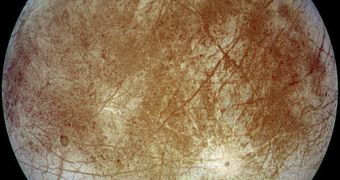A team of astronomers managed to capture an amazing series of pictures of the South Equatorial Belt feature on Jupiter on November 30, 2010, with a little help from one of the most interesting moons in orbit around the gas giant, Europa.
The study was conducted because the trademark atmospheric feature Jupiter had disappeared a little while back, and is currently reemerging slowly. Investigators are really interested about what caused the disappearance, and the comeback.
As such, they used the new adaptive optics (AO) system on the Keck II telescope, one of the two instruments making up the W. M. Keck Observatory, atop Mauna Kea, in Hawaii.
Featuring two, 10-meter telescopes, the observatory is only exceeded by the Gran Telescopio Canarias as the world's largest optical space observations facility. The Keck II telescope, which was completed back in 1996, was recently upgraded with the new AO system.
The optical equipment can snap photos in thermal infrared light at wavelengths including 1.21, 1.58, 1.65, and 5 microns. This allows unprecedented penetration power for this instrument. All these wavelengths were used for the new study.
“The thermal IR senses breaks in the cloud cover,” explains University of California in Berkeley (UCB) astronomer and investigator Mike Wong, quoted by SpaceRef.
In the new views, the 5-micron images are overlaid over another view of the planet, collected in the 3 other IR bands. The product is then put in contrast with visible light images of the gas giant.
The result is a photo of thinning, breaking layer of high, bright, icy clouds on the planet. These structures have obscured our view of the South Equatorial Belt (SEB) for about a year.
“We see wispy cloud-free regions at 5 microns in the SEB. But they are much less extensive than the near-infrared dark regions surrounding them,” Wong explains.
“The data show that the change from zone-like to belt-like appearance is a complex process that takes place at different speeds in each layer of Jupiter's atmosphere,” he goes on to say.
In order to conduct the new study, and capture these images, astronomers needed an artificial guide star, which is commonly used to calibrate AO systems. But there was no way to use lasers for this purpose on Jupiter. Lasers are generally used for such applications.
As such, the astronomers turned to the moon Europa, and used it as a reference point to calibrate Keck II's AO system. The moon only came in position on November 30, 2010.
The reason why using AO is so important is because it compensates for the flicker induced in light radiation by Earth's atmosphere. Adaptive optics can literally eliminate this influence, making it seem as if astronomers are watching the sky from a planet without an atmosphere.

 14 DAY TRIAL //
14 DAY TRIAL //